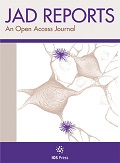Authors: Beishon, Lucy C. | Panerai, Ronney B. | Robinson, Thompson G. | Subramaniam, Hari | Haunton, Victoria J.
Article Type:
Research Article
Abstract:
Background: The incidence of dementia is predicted to rise rapidly, but sensitive diagnostic tests remain elusive. Changes in cerebral blood flow velocity (CBFv) can occur at an early stage of cognitive decline, and can be measured by transcranial Doppler ultrasonography (TCD). Objective: The aim of this study was to characterize the CBFv changes that occur in healthy older adults (HC), mild cognitive impairment (MCI), and Alzheimer’s disease (AD), in response to a language task from the Addenbrooke’s cognitive examination (ACE-III). Methods: Participants underwent bilateral TCD, continuous heart rate (ECG), end-tidal CO2 (capnography, ETCO2 ),
…and beat-to-beat blood pressure (Finometer, MAP), monitoring, during a 5-minute baseline, followed by cognitive tasks from the ACE-III. Data are presented for a language task (repeating words and phrases aloud), as peak percentage change in CBFv, HR, MAP, and ETCO2 from a normalized baseline. Results: 30 participants (mean age 73.2 years, 20% female) were recruited; HC (n = 10), MCI (n = 10), AD (n = 10). Language scores did not differ between groups (p = 0.16). Peak percentage change in CBFv differed between groups with the language task (HC: 15.9 (7.5)%, MCI: 6.7 (4.5)%, AD: 0.1 (7.1)%; p < 0.005). However, changes in MAP (HC: 7.9 (4.6)%, MCI: –0.1 (0.9)%, AD: 0.9 (4.4)%; p < 0.005), HR (HC: 8.8 (8.2)%, MCI: 0.7 (4.3)%, AD: –0.5 (5.6)%; p = 0.005), and ETCO2 (HC: –0.9 (3.2)%, MCI: 0.9 (3.2)%, AD: –5.2 (5.7)%; p = 0.006), also occurred. Conclusions: TCD measured CBFv changes to a language task from the ACE-III was feasible in a cognitively impaired population, further work is required in a larger population.
Show more
Keywords: Alzheimer’s disease, cerebral blood flow, dementia imaging, mild cognitive impairment
DOI: 10.3233/ADR-180068
Citation: Journal of Alzheimer's Disease Reports,
vol. 2, no. 1, pp. 153-164, 2018





